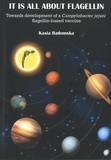IT IS ALL ABOUT FLAGELLIN
Towards the development of Campylobacter jejuni flagellin-based vaccine
Summary
Campylobacter jejuni is the most common cause of bacterial zoonosis worldwide. Vaccination of poultry is one potential strategy to reduce the incidence of campylobacteriosis in humans, as chickens are a major bacterial reservoir. Several types of vaccines have been developed but none of the whole cell vaccines or subunit vaccines has thus far resulted in the desired protection of chicken against colonization by C. jejuni. The main objective of the work described in this thesis was to provide a scientific basis for the development and production of a C. jejuni flagellin-based vaccine for use in chickens. We focused on flagellin as candidate vaccine component as this protein is the main antigen recognized during colonization and because flagellin-specific antibodies are part of the chicken maternal immunity that effectively prevents C. jejuni colonization up to 2 3 weeks post-hatch.
The primary aim of the work described in this thesis was to provide a scientific basis for the development and production of a flagellin-based vaccine against C. jejuni for use in chickens. Specific objectives were: 1) to determine the immune response of chicken towards recombinant NHC flagellin after in ovo delivery, 2) to enlarge the much needed knowledge concerning the processing of flagellins during flagella biogenesis in C. jejuni, and 3) to exploit the gained knowledge in engineering of glycosylated vaccine producing strain. Chapter 2 describes the in ovo administration, immunogenicity and protective effect of a recombinant NHC vaccine in broiler chickens. Chapter 3 reports on the discovery of a novel flagellin-binding partner, the flagellar protein FliW, and its crucial role in the regulation of cytoplasmic flagellin levels in C. jejuni. In Chapter 4, the putative flagellin chaperone FliS, its importance in flagella biogenesis and flagellin secretion, and the successful mapping the FliS and FliW binding sites in flagellin are described. In Chapter 5, the glycosylated NHC subunit vaccine producing strain was constructed and the potential flagellin O glycosyltransferase needed for attachments of the glycans to the flagellin was identified. In Chapter 6, the major findings of this thesis are summarized and discussed. The gained knowledge can be exploited for the rational design of a Campylobacter microbial cell factory that produces a glycosylated flagellin-based subunit vaccine.
